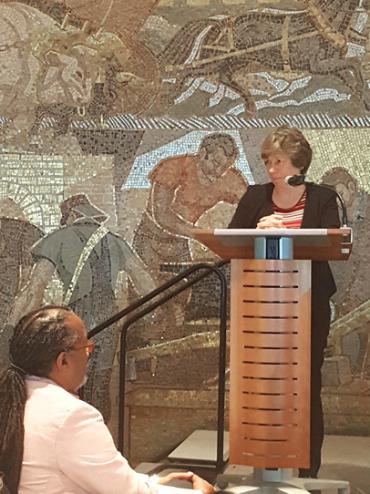Leaders in education, labor and civil rights packed AFL-CIO headquarters in Washington, D.C., this month for the" Grow Your Own: Teacher Diversity and Social Justice Summit," a provocative and engaging series of presentations that showcased the power of effective home-grown methods for addressing the teacher shortage and for identifying, preparing and retaining teachers of color who live in the communities where they work.
Co-sponsored by the AFT and the National Education Association, the May 17-18 summit included more than 150 leaders from organizations around the nation—groups representing state legislators, superintendents, administrators, teachers, students, labor, researchers, higher education leaders, civil rights and social justice leaders, and faith-based organizations. AFT President Randi Weingarten helped set the tone with opening remarks that highlighted necessary steps to address a problem that has "reached a crisis point" in the nation: the lack of teacher diversity, particularly the sharp decline in African-American, Latino and Native American teachers.
The work requires "a deliberate focus on recruiting teachers of color and supporting them throughout their careers," Weingarten told the crowd, and it must take place city by city, community by community, neighborhood by neighborhood. And it needs a friendly professional landscape to support it—one that brings respect and dignity to the profession, and returns the joy of teaching and learning to the classroom.
Research shows compelling benefits of a teaching force that truly reflects the country's growing diversity, Weingarten pointed out, and those benefits extend throughout the school community. Positive exposure to individuals from a variety of races and ethnic groups, especially in childhood, can help reduce negative stereotypes and unconscious implicit biases. And low-income black and brown students who have just one teacher of color in grades 3-5 are more likely to stay in school and be recommended for AP courses, to graduate from high school and to consider college.
These studies contain a powerful message about students of color that should not be lost in the public arena, remarked conference participant Margarita Bianco, who runs the Pathways2Teaching program in Denver: "You can't be who you don't see."
These findings also are a call to collective action. Now is the time for recruiting and training teachers in our communities—and supporting them "not only in the classroom but [with] issues of affordable housing, community involvement and mentoring," said Weingarten, pointing to good models of this work in Baltimore, Denver and Pittsburgh. Connections are keys to success; There must be strong bridges between local school districts, communities, state governments and higher education. And historically black colleges and universities Hispanic-serving institutions, and tribal colleges and universities must remain in the vanguard of the effort. "We consider strong relationships with HBCUs, HSIs, and tribal colleges and universities a linchpin to the success of our 'grow your own' strategies," the AFT president added.
[Staff reports]

